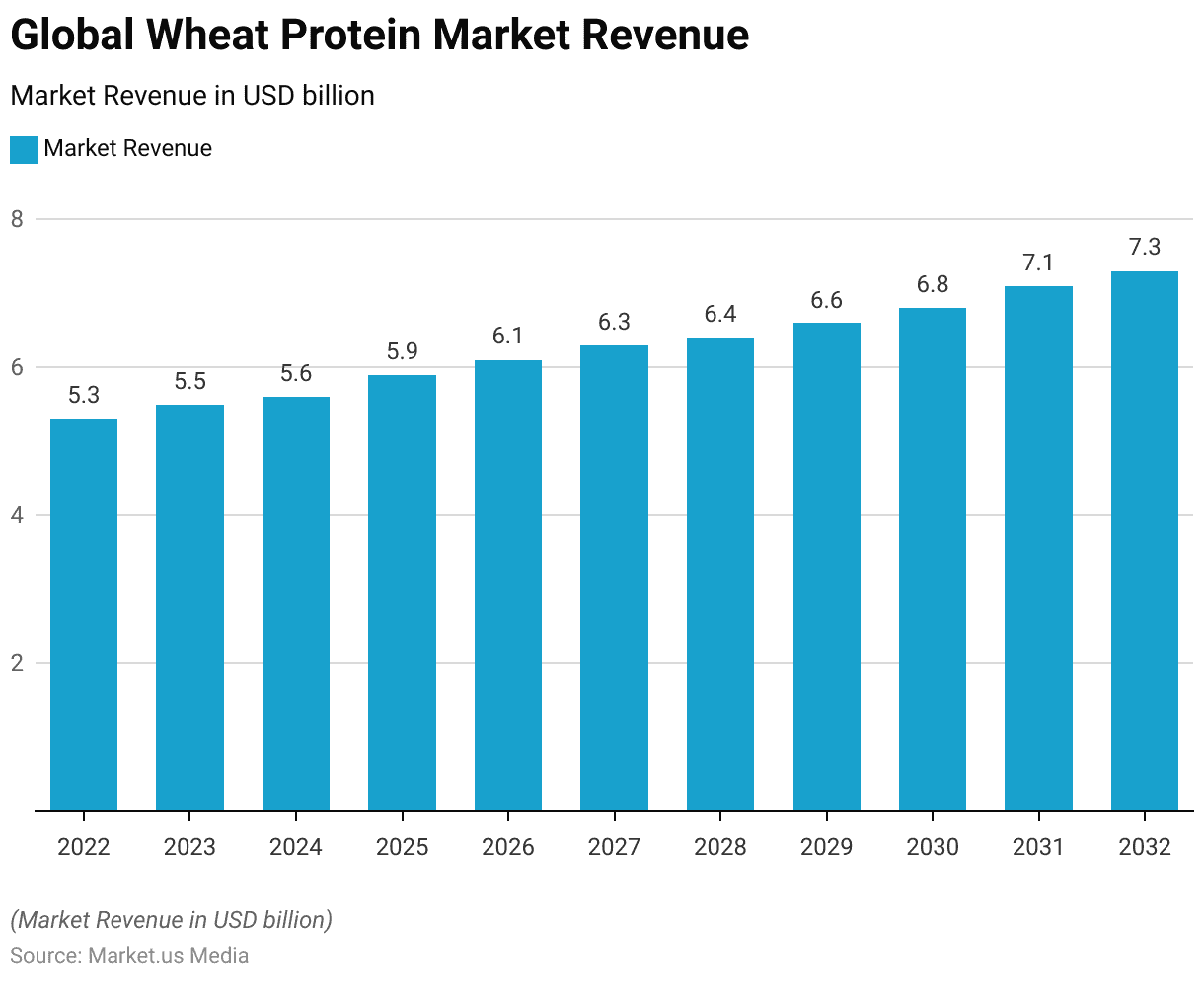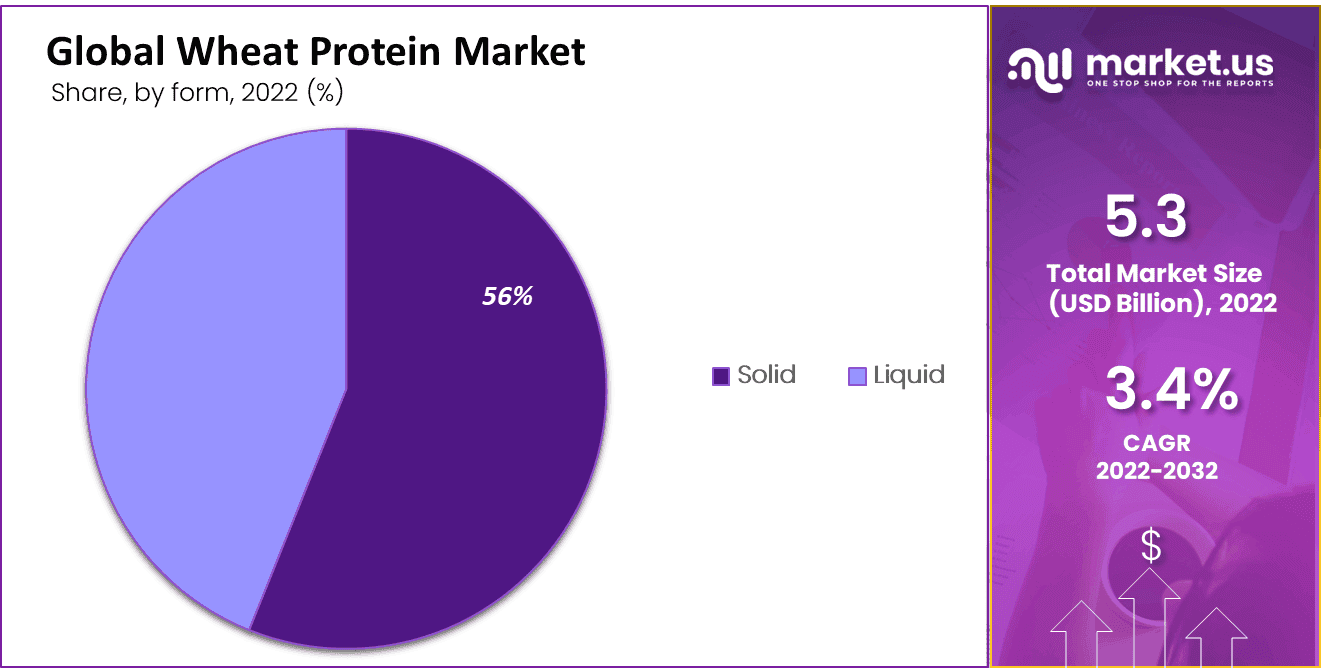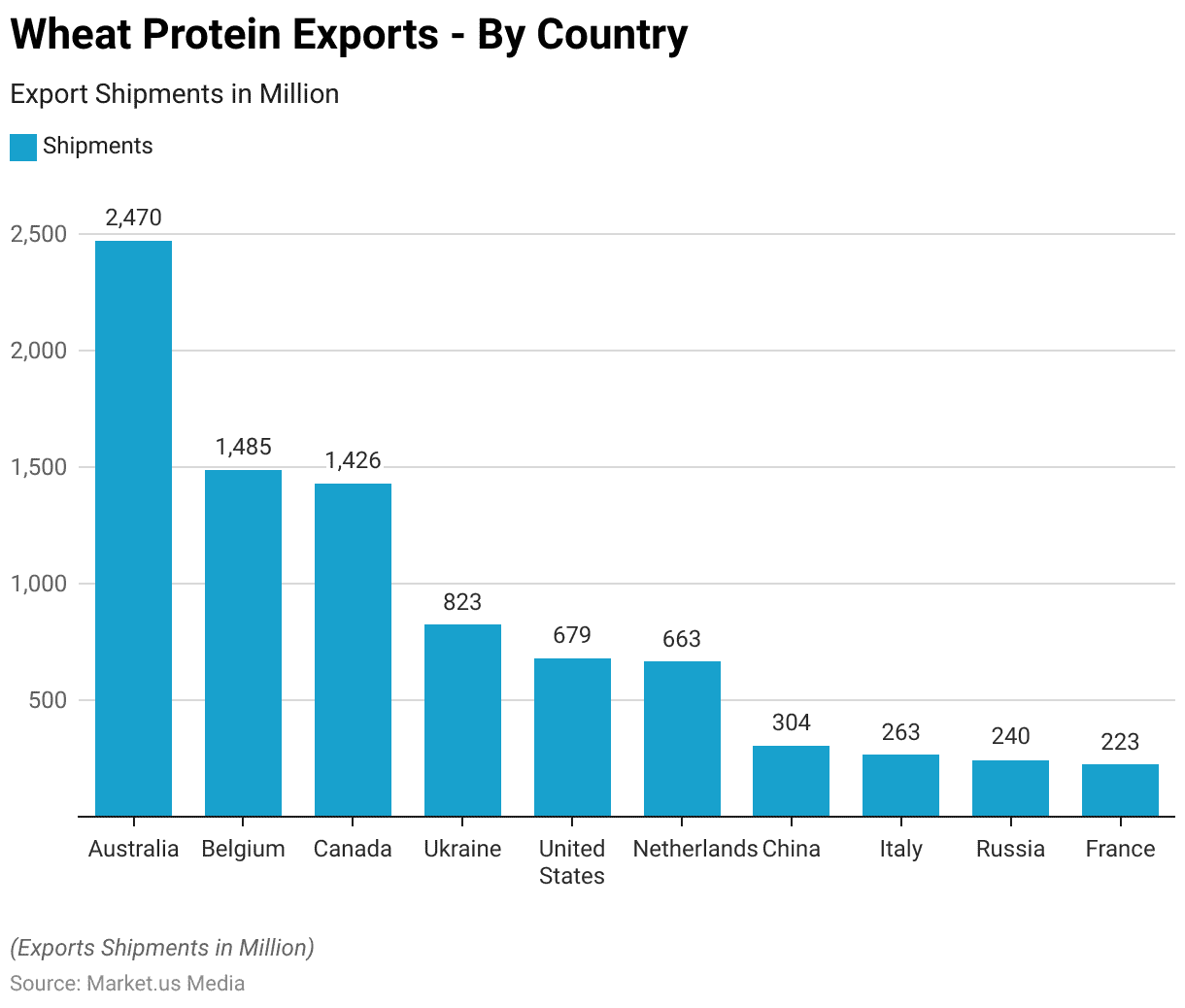Table of Contents
Introduction
According to Wheat Protein Statistics, Wheat protein, with its distinct types including wheat gluten, protein isolate, textured wheat, and hydrolyzed protein, plays a crucial role in various industries due to its unique properties.
This Wheat gluten, known for its elasticity, is indispensable in baking and as a meat substitute. Wheat protein isolate, protein ingredients, is favored in dietary supplements and high-protein, low-carbohydrate foods.
Textured protein is popular in vegetarian and vegan diets for its meat-like texture, while hydrolyzed protein is utilized in cosmetics for its conditioning properties.
These applications span food and beverages, animal feed, personal care, and even industrial uses, underlining the versatility and significance of protein in meeting dietary needs, improving product textures, and supporting sustainability efforts across different sectors.
Editor’s Choice
- The global wheat protein market revenue reached USD 5.5 billion in 2023.
- The trend culminated in 2032, when the market peaked at USD 7.3 billion, segmented into USD 3.07 billion from wheat gluten, USD 1.31 billion from protein isolate, USD 1.24 billion from textured protein, and USD 1.68 billion from hydrolyzed wheat protein.
- As of the latest data, solid forms of protein hold a majority market share of 56%, underscoring their widespread use and preference in various applications.
- Wheat gluten, a key protein variant, is rich in nutrients, especially protein, which makes up about 75-80g per 100g.
- Australia leads as the top exporter of protein, boasting shipments totaling 2,470 million.
- The United States stands as the leading importer of protein, with shipments reaching 4,054 million, highlighting its significant demand in the country.
- Research indicates that the UAE can enhance protein yields by 10-20% over conventional methods.

Global Wheat Protein Market Overview
Wheat Protein Market Size
- The global wheat protein market has exhibited a steady growth trajectory from 2022 to 2032 at a CAGR of 3.40%.
- Starting at a revenue of USD 5.3 billion in 2022, the market witnessed a slight increase to USD 5.5 billion in 2023, followed by a marginal rise to USD 5.6 billion in 2024.
- The upward trend persists, with market revenues reaching USD 6.6 billion in 2029, USD 6.8 billion in 2030, and eventually climbing to USD 7.1 billion in 2031.
- This consistent growth will culminate in a market size of USD 7.3 billion by 2032, reflecting the increasing global demand and application of wheat protein across various industries.

Global Wheat Protein Market Size – By Product
- The global wheat protein market, delineated by product categories, has demonstrated a progressive increase in revenue from 2022 to 2032.
- In 2022, the market initiated with a total revenue of USD 5.3 billion, divided among its primary segments as follows: wheat gluten at USD 2.23 billion, protein isolate at USD 0.95 billion, textured wheat at USD 0.90 billion, and hydrolyzed protein at USD 1.22 billion.
- By 2023, total market revenue edged up to USD 5.5 billion, with incremental growth in each category, marking a continuous upward trend.
- The trend culminated in 2032, when the market peaked at USD 7.3 billion, segmented into USD 3.07 billion from wheat gluten, USD 1.31 billion from protein isolate, USD 1.24 billion from textured protein, and USD 1.68 billion from hydrolyzed wheat protein.

Global Wheat Protein Market Share – By Form
- In the wheat protein market, product forms are predominantly categorized into solid and liquid, each capturing a significant portion of the market.
- As of the latest data, solid forms of protein hold a majority market share of 56%, underscoring their widespread use and preference in various applications.
- On the other hand, liquid forms of protein account for 44% of the market.

Nutritional Components of Wheat Gluten (per 100g)
- Wheat gluten, a key protein variant, is rich in nutrients, especially protein, which makes up about 75-80g per 100g.
- It has low-fat levels, around 1.5-2g per 100g, and a moderate carbohydrate count of 5-14g per 100g, with some of this being dietary fiber, particularly in whole wheat products.
- Micronutrient-wise, it’s a source of essential B vitamins like niacin, thiamine, and folate, alongside minerals such as iron, magnesium, phosphorus, and zinc.
- However, its protein, though abundant, lacks lysine, making it necessary to pair with other proteins for a complete amino acid profile.
- With a calorie count of 300-370 kcal per 100g, wheat gluten is nutritionally dense and beneficial for those looking to enhance their diet with proteins and vital nutrients. Yet, it’s not suitable for individuals with gluten intolerance.
Top Wheat Protein Exporting Nations
- Australia leads as the top exporter of protein, boasting shipments totaling 2,470 million, followed by Belgium and Canada with 1,485 million and 1,426 million, respectively.
- Ukraine also contributes significantly to the global protein market with 823 million, while the United States exports 679 million.
- The Netherlands is not far behind, exporting 663 million.
- Meanwhile, China, Italy, Russia, and France have lower, yet notable, export figures of 304 million, 263 million, 240 million, and 223 million, respectively.

Top Wheat Protein Importing Nations
- The United States stands as the leading importer of protein, with shipments reaching 4,054 million, highlighting its significant demand in the country.
- Vietnam follows as a major importer with 1,392 million, and Uganda is close behind with 1,281 million. Peru also plays a crucial role in the protein import market, bringing in 1,228 million.
- India’s imports are notable as well, totaling 678 million, while Kenya imports 510 million, demonstrating the importance of protein in their dietary consumption.
- Indonesia and South Korea have more modest figures, importing 278 million and 178 million, respectively.
- Ghana and the Philippines, though smaller in volume, still contribute to the global import landscape with 85 million and 68 million, indicating a widespread reliance on wheat protein across diverse nations for its nutritional benefits and applications in food production.

Parentage of Bread Wheat Genotypes
- The variety of bread wheat genotypes reflects a broad spectrum of crossbreeding endeavors aimed at enhancing nutritional qualities, disease resistance, and overall yield.
- For example, the high zinc variant, PBW 1 Zn, is a result of complex breeding involving T.DICOCCON CI 9309/Ae.sq(409)/3/Milan/S.
- 87230 and BAV 92 to boost zinc levels. Genetic varieties like BWL 9023 and BWL 1663/1664, which come from crosses such as MILAN/AMSEL and GLUPRO/3∗PBW 568, showcase targeted improvements.
- C-derivatives and PBW-175 lines, including BWL 3498 and 3500 series, result from strategic crosses with WL 711-Ae. Ovata, aiming for advanced traits.
- C-lines like C 306 and C 273, as well as rainfed varieties such as PBW 175 and its derivatives, are bred for specific improvements like drought tolerance.
- This effort extends to PBW-621 derivatives and acknowledges the value of local strains, such as HIMACHAL LOCAL-1, in wheat’s genetic development.
Latest Innovations in Wheat Protein Extraction and Processing
Enzymatic Extraction
- Studies suggest enzymatic extraction can significantly increase protein yield while reducing energy consumption compared to traditional methods.
- The specificity of enzymes can lead to purer protein extracts with fewer processing steps.
Ultrasound-Assisted Extraction (UAE)
- Research indicates that the UAE can enhance protein yields by 10-20% over conventional methods.
- The reduction in extraction time and solvent use also contributes to cost savings and a lower environmental footprint.
Aqueous Two-Phase Systems (ATPS)
- ATPS can achieve high purity levels of wheat protein isolates, with some studies reporting up to a 90% purity rate.
- This method also allows for the recovery and reuse of solvents, improving overall sustainability.
Membrane Filtration Techniques
- Concentration and Purification: Membrane filtration can concentrate wheat proteins up to 5-10 times their original concentration in the extract, with a high degree of purity.
- This method is particularly effective in removing contaminants and smaller molecular weight substances.
High-Pressure Processing (HPP)
- HPP can lead to an increase in solubility and improvement in functional properties such as emulsification capacity and foam stability, which are crucial for food applications.
- The exact improvements can vary based on processing conditions and the wheat protein type.
Discuss your needs with our analyst
Please share your requirements with more details so our analyst can check if they can solve your problem(s)



